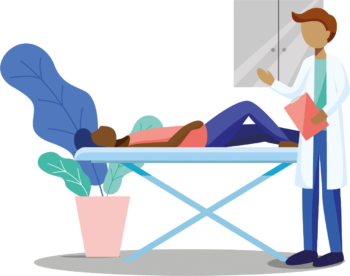By Christina DeBusk

More than one in five adult Americans live with chronic pain, according to a report issued by the Centers for Disease Control and Prevention (CDC). For 17.1 million of these individuals, their pain is enough to substantially limit their daily activities.
If you are experiencing long-term pain and looking for relief, chiropractic may help via its whole-person approach to care—even if your pain isn’t musculoskeletal in nature. This is something that Mia R. Ortega, DC, DIANM, MAEd, an American Chiropractic Association (ACA) member who practices in Fredericksburg, Va., has experienced firsthand with her patients, offering them the results they’re searching for.
One Patient’s Pain Relief via Chiropractic’s Whole-Person Care
“This one actually surprised me,” says Dr. Ortega, who recounts a patient that came to see her after dealing with severe pain for years. “He couldn’t really identify a specific joint, or muscle, or movement, or anything. He did, however, say he had daily headaches too but that, in general, his pain was everywhere.”
The patient was a manual laborer, but his pain had gotten so severe that he was no longer working. “This of course affected his stress and his home life,” Dr. Ortega recalls. “It was apparent that not only was he in a lot of pain, but he was also very upset about his situation.”
While discussing the patient’s health history, Dr. Ortega learned that the patient never drank water. “He had one cup of coffee every morning and a few sodas during the day, but that was it,” she said. Upon learning this, Dr. Ortega talked with the patient about the physiological benefits of proper hydration.
The CDC shares that these benefits include:
- helping your body stay at a healthy temperature.
- offering lubrication and cushioning for your joints.
- protecting your spinal cord and other bodily tissues.
- assisting with waste elimination through sweating, urination and bowel movements.
Moving forward, Dr. Ortega worked with the patient to help him slowly increase his water intake to eight glasses per day, along with eliminating the soda. The results were dramatic. 
“He saw me again just two weeks later, happy and smiling when he greeted me,” shares Dr. Ortega. “He was carrying a bottle of water with him and was excited to show me that he was committed to staying hydrated. He said that after drinking water, his pain went away completely. He had no more headaches, he could move and was walking with his wife daily, and he was going to go back to work again. Even I wasn’t expecting such a dramatic outcome from drinking water!”
What Is Chiropractic’s Whole-Person Approach?
Dr. Ortega was able to offer this patient and many others pain relief by using chiropractic’s whole-person approach to care. But what exactly does this mean? Dr. Ortega likens it to “putting together the pieces of a puzzle.”
This approach involves not just looking at a patient’s diagnostic tests but also considering their life as a whole. “I’m listening as the patient tells me about their injury,” she explains, “but also asking about their family history, sleeping patterns, exercise routine, hydration habits, diet, workstation setup, stress, smoking or drinking habits, and so on. I’m also asking about their daily activities, their limitations, and their goals. By the end of the history-taking portion of the exam, I have a pretty good idea of what the patient’s day-to-day looks like.”
The reason this approach works is because several factors can contribute to persistent pain. Identifying the ones that are present in the patient’s life is important in providing a positive outcome. It’s also typically an eye-opener for patients.
“Patients are often surprised in our initial exam because they hadn’t considered how these other things that have been a part of their routine life for so long might actually be prolonging their pain,” Dr. Ortega explains.
Using a whole-person approach can also instill hope in patients who may think that there are no solutions that will solve their chronic pain long-term. “By the time the patient sees me, they’ve already seen other providers,” says Dr. Ortega. “They’ve had unremarkable imaging, were told they weren’t candidates for surgery, or had only temporary relief from other therapies and treatments. So, when they come to my consult, they might not be too optimistic after having tried so many other approaches and not getting long-term improvement. It’s great to see them light up when they learn there may be other contributory factors that they may not have considered before.”
Other Benefits of a Whole-Person Approach
Treating the whole patient during chiropractic visits isn’t just good for resolving pain issues either. “I think the best part of this approach is that not only are patients more educated on how to reduce their pain and prevent exacerbations, but they’re also making new decisions and taking charge in changing their lifestyle and developing better habits,” says Dr. Ortega.
Among some of the habits that this approach encourages are:
- finding ways to reduce stress.
- getting regular exercise and/or being more physically active.
- achieving and maintaining a healthy weight.
Developing positive health habits can also help patients feel more confident while engaged in activities they enjoy, Dr. Ortega adds. It encourages them to look at their habits and lifestyle and how these factors may be contributing to their issues.
“The nature of our profession makes us consider more than just what’s on the surface,” she says. “Chiropractors dig a little deeper than just asking about pain. We ask what the patient’s limitations are, what would they like to improve, and what goals they have.”
While Dr. Ortega admits that chiropractic’s whole-person approach means that doctors in this field must learn a wide range of health information, she’s also grateful to have such a broad education. “Now, I certainly see the value in learning about nutrition, rehabilitation, patient communication, and so on,” she says.
This education not only helps her get to the bottom of her patient’s issues, but also offers her patients benefits that expand to those around them. “I’d like to think that patients leave each chiropractic visit learning something new about themselves,” says Dr. Ortega, “and sharing what they’ve learned about maintaining a healthy lifestyle with their friends and family.”
A Call for Better Chiropractic Coverage for Seniors
Although a whole-person approach offers many benefits, chiropractors face challenges when using it for certain patients, namely seniors. “Current Medicare policy limits our treatment [of beneficiaries] to just spinal adjustments,” Dr. Ortega explains.
This means that any other parts of a whole-person treatment plan, which includes things such as nutrition education and exercises, must be paid for by patients out of pocket. “This can be difficult to do on a limited budget,” she notes.
That’s why Dr. Ortega is urging other chiropractic professionals and their patients to encourage legislators to support the Chiropractic Medicare Coverage Modernization Act (H.R. 1610 / S. 799). If enacted, the legislation would increase coverage of services for Medicare patients who receive chiropractic treatment, which focuses on reducing pain and improving function using non-drug treatment options.
The bill is close to Dr. Ortega’s heart because, she explains, it serves such a valuable purpose: “So that our beloved elderly patients can also experience the benefits of the ‘whole person’ approach to healthcare.”
For more information on health and wellness, or to find a chiropractor near you, visit www.HandsDownBetter.org.
Reviewed by the ACA Editorial Advisory Board. The information in this post is for educational purposes. It is not a replacement for treatment or consultation with a healthcare professional. If you have specific questions, contact your doctor of chiropractic. To find an ACA chiropractor near you, click here.
Christina DeBusk is a freelance contributor to HandsDownBetter.org.



